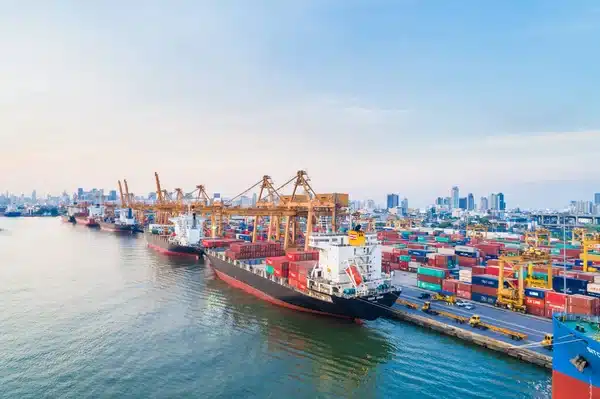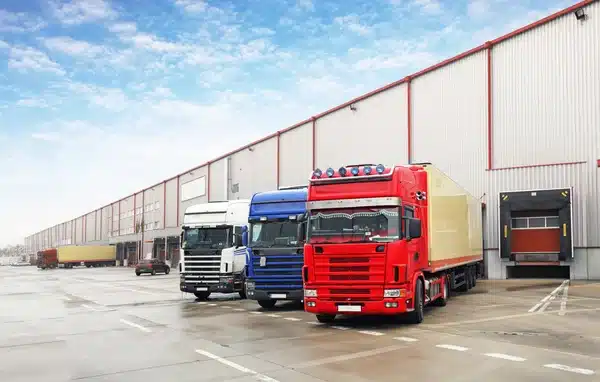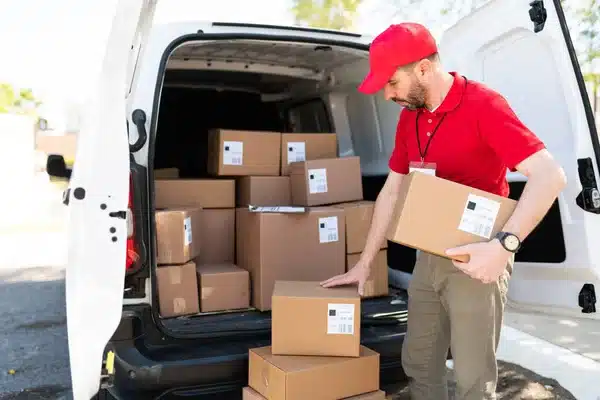Door-to-door shipping from China offers an all-inclusive logistics solution for businesses and individuals looking to transport goods internationally. By taking care of the entire supply chain—from pick-up at the origin to delivery at the final destination—this shipping method minimizes hassle, reduces risks, and saves time. It is particularly popular among e-commerce sellers, importers, and manufacturers who seek a seamless experience without having to navigate complex logistics processes.
This guide delves deep into the nuances of door-to-door shipping from China, covering its advantages, shipping options, costs, transit times, and essential tips for optimizing the process.

Table of Contents
What Is Door-to-Door Shipping?
Door-to-door shipping involves the transportation of goods from the shipper’s location in China to the recipient’s specified address in the destination country. The process includes:
- Pick-Up: Collecting goods from the supplier’s location.
- International Transportation: Shipping via air, sea, or rail.
- Customs Clearance: Managing export and import formalities.
- Final Delivery: Delivering goods to the recipient’s address.
This all-inclusive solution ensures a smooth logistics experience, eliminating the need for multiple service providers.
Benefits of Door-to-Door Shipping from China
1. Hassle-Free Logistics
With a single service provider managing the entire process, you avoid the complexities of coordinating with multiple agents or handling customs formalities.
2. Cost Transparency
All-inclusive pricing eliminates hidden fees, helping you budget effectively.
3. Time Savings
The streamlined process reduces delays, ensuring timely delivery of goods.
4. Risk Reduction
Minimized handling reduces the risk of damage or loss during transit.
5. Flexibility
Door-to-door services cater to various shipping needs, offering options like DDP (Delivered Duty Paid) and DDU (Delivered Duty Unpaid).

Difference Between Door-to-Door and DDP Shipping from China
Door-to-Door Shipping and Delivered Duty Paid (DDP) shipping are commonly used terms in international logistics. While they share similarities, they cater to different shipping needs. Here’s how they differ:
Door-to-Door Shipping
- Definition: A logistics service where goods are picked up from the supplier’s location in China and delivered directly to the buyer’s address in the destination country.
- Inclusions:
- Pickup from the supplier.
- International transportation (sea, air, or rail).
- Final delivery to the buyer’s address.
- Customs and Duties:
- The buyer is responsible for handling customs clearance and paying duties/taxes.
- Best For:
- Businesses that prefer to manage customs themselves or have a customs broker.
- Example:
- A shipment from Shenzhen is delivered to a warehouse in Los Angeles, with the buyer handling import duties.
Delivered Duty Paid (DDP) Shipping
- Definition: A shipping service where the seller assumes responsibility for all costs, including customs clearance, duties, and taxes, ensuring a hassle-free experience for the buyer.
- Inclusions:
- All services in door-to-door shipping.
- Customs clearance at the destination.
- Payment of import duties and taxes.
- Customs and Duties:
- The seller handles everything; the buyer receives the goods fully cleared.
- Best For:
- Buyers seeking convenience and wanting to avoid dealing with customs.
- Example:
- A shipment from Guangzhou is delivered to a store in New York, with the seller covering all customs-related expenses.
Key Differences
| Feature | Door-to-Door | DDP |
|---|---|---|
| Customs Responsibility | Buyer | Seller |
| Payment of Duties/Taxes | Buyer | Seller |
| Convenience | Moderate | High |
| Cost | Lower | Higher (due to inclusive services) |
Benefits of Door-to-Door Shipping from China
- Simplified Logistics: One-stop service from origin to destination.
- Cost Efficiency: Potential savings through bundled services.
- Customs Expertise: Professional handling of documentation and regulations.
Trade Terms and Shipping Methods
Popular Shipping Methods for Door-to-Door Services
- Door-to-Door Ocean Shipping from China: Ideal for bulky goods or large shipments. Economical but slower compared to air freight.
- Air Freight Door-to-Door Shipping from China: Fastest option, suitable for urgent or high-value goods.
- Rail Freight Door-to-Door Shipping from China: Cost-effective for shipments to Europe or Central Asia, with balanced speed and cost.
- Road Transport Door-to-Door Shipping from China: Often used for shipments to nearby countries like Vietnam, Laos, or Mongolia.
Trade Terms and Services for Door-to-Door Shipping from China
- Incoterms: Commonly used terms include DDP and DDU.
- Customs Clearance Services: Includes documentation, duty payment, and compliance checks.
- Consolidated Shipping: Reduces costs for smaller shipments by combining goods from multiple customers.
What Are the Main Routes for Door-to-Door Shipping from China?
Door-to-door shipping from China utilizes various transport modes to deliver goods to global destinations. The main routes depend on the type of transportation—sea freight, air freight, or rail freight—and the target destination. Here’s an overview of the key routes:
Sea Freight Routes
Sea freight is the most cost-effective option for heavy or bulky shipments. Major routes connect China’s busiest ports to global destinations.
China to the USA:
- Ports: Shanghai, Shenzhen, Ningbo → Los Angeles, Long Beach, New York.
- Route: Trans-Pacific shipping.
China to Europe:
- Ports: Shanghai, Tianjin, Guangzhou → Rotterdam, Hamburg, Antwerp.
- Route: Suez Canal route or Arctic route during summer months.
China to Southeast Asia:
- Ports: Shenzhen, Guangzhou, Xiamen → Singapore, Port Klang (Malaysia), Manila.
- Route: Short-haul regional shipping.
Air Freight Routes
Air freight is the fastest option, ideal for time-sensitive shipments. Goods are transported from China’s major airports to key global hubs.
- Airports: Beijing (PEK), Shanghai (PVG), Guangzhou (CAN) → Los Angeles (LAX), Chicago (ORD), Miami (MIA).
- Airports: Shenzhen (SZX), Chengdu (CTU), Hong Kong (HKG) → Frankfurt (FRA), London (LHR), Paris (CDG).
- Airports: Guangzhou (CAN), Hong Kong (HKG), Xi’an (XIY) → Dubai (DXB), Doha (DOH), Riyadh (RUH).
Rail Freight Routes
Rail freight offers a cost-effective and relatively fast solution for shipments to Europe, connecting via the China-Europe Railway Express.
- China to Europe:
- Main Stations: Chengdu, Xi’an, Zhengzhou → Duisburg, Hamburg, Warsaw.
- Route: Overland via Kazakhstan, Russia, and Belarus.
Combined Shipping Routes
For door-to-door services, shipping routes often combine multiple transport modes (e.g., sea and air, rail and road) to optimize delivery.
- Sea and Road:
- Example: Shanghai to Los Angeles by sea, followed by truck delivery to inland US locations.
- Rail and Road:
- Example: Chengdu to Hamburg by rail, with road transport to other European cities.
Popular Destinations for Door-to-Door Shipping from China
Door-to-door shipping from China is widely used by businesses and individuals across the globe. The flexibility, cost-effectiveness, and convenience of this service make it ideal for delivering goods to key markets. Below are some of the most popular destinations for door-to-door shipping from China:
United States
- Why Popular: Strong trade ties with China and a high demand for electronics, textiles, and machinery.
- Key Destinations:
- West Coast: Los Angeles, San Francisco, Seattle.
- East Coast: New York, Miami, Chicago.
- Gulf Coast: Houston, New Orleans.
Europe
Southeast Asia
Middle East
- Why Popular: High demand for construction materials, electronics, and consumer goods.
- Key Destinations:
- UAE (Dubai, Abu Dhabi), Saudi Arabia (Riyadh, Jeddah), Qatar (Doha).
Africa
South America
- Why Popular: Strong trade agreements and consistent demand for manufactured goods.
- Key Destinations:
- Australia (Sydney, Melbourne), New Zealand (Auckland, Wellington).
Regional Door-to-Door Shipping Guides:

Door-to-Door Shipping Prices and Times from China
Door-to-door shipping costs and transit times vary significantly based on the shipping method, destination, cargo size, and specific service requirements. Below is a detailed breakdown to help you understand the pricing and timelines for different shipping options:
Ocean Freight Door-to-Door Shipping
Ocean freight is the most economical method for shipping large or bulky items. It’s ideal for businesses shipping full container loads (FCL) or less-than-container loads (LCL).
| Destination | Transit Time (Days) | Cost Range (USD) |
|---|---|---|
| USA (e.g., Los Angeles) | 25-35 | $2,000-$3,500 (FCL) |
| Europe (e.g., Rotterdam) | 30-40 | $2,200-$3,800 (FCL) |
| Australia (e.g., Sydney) | 20-30 | $2,100-$3,600 (FCL) |
| Africa (e.g., Lagos) | 40-50 | $2,500-$4,000 (FCL) |
Key Points:
- LCL Services: More affordable for smaller shipments, though transit times may be slightly longer due to consolidation.
- Best for: Large shipments, non-urgent goods, and heavy cargo.
Air Freight Door-to-Door Shipping
Air freight is the fastest shipping option, suitable for time-sensitive or high-value goods.
| Destination | Transit Time (Days) | Cost Range (USD/kg) |
|---|---|---|
| USA (e.g., New York) | 5-8 | $5-$8 |
| Europe (e.g., Frankfurt) | 5-7 | $6-$9 |
| Middle East (e.g., Dubai) | 4-6 | $5-$7 |
| Africa (e.g., Nairobi) | 6-8 | $6-$10 |
Key Points:
- Small Parcels: Competitive pricing for light shipments under 100kg.
- Best for: Urgent deliveries, perishable goods, and electronics.
Rail Freight Door-to-Door Shipping
Rail freight offers a balance between cost and speed for shipments to Europe and Central Asia.
| Destination | Transit Time (Days) | Cost Range (USD) |
|---|---|---|
| Europe (e.g., Hamburg) | 15-20 | $3,000-$4,500 (FCL) |
| Russia (e.g., Moscow) | 12-18 | $2,500-$4,000 (FCL) |
| Central Asia (e.g., Almaty) | 10-15 | $2,000-$3,500 (FCL) |
Key Points:
- Green Logistics: Lower carbon footprint compared to air freight.
- Best for: Medium-sized shipments with moderate urgency.
Road Transport Door-to-Door Shipping
Road freight is suitable for shipments to neighboring countries or regions with strong cross-border connections.
| Destination | Transit Time (Days) | Cost Range (USD) |
|---|---|---|
| Vietnam (e.g., Hanoi) | 7-10 | $1,000-$2,000 |
| Laos (e.g., Vientiane) | 5-8 | $800-$1,500 |
| Mongolia (e.g., Ulaanbaatar) | 10-15 | $1,500-$2,500 |
Key Points:
- Flexible Routes: Suitable for door-to-door delivery in remote regions.
- Best for: Small to medium shipments within Asia.
Factors Affecting Door-to-Door Shipping Prices
- Cargo Type and Size: Larger shipments or hazardous goods incur higher costs.
- Destination Country: Customs duties, taxes, and local delivery charges can vary.
- Shipping Method: Air freight is the most expensive, while sea freight offers the lowest cost.
- Peak Seasons: Shipping during Chinese New Year or Black Friday may increase prices.
Comparison of Shipping Costs Across Methods: Air, Sea, and Rail
Choosing the right shipping method depends on factors like budget, delivery speed, and cargo type. Here’s a detailed comparison of the shipping costs for air freight, sea freight, and rail freight from China to various destinations.
Cost Comparison Table
| Shipping Method | Cost Range | Best For | Limitations |
|---|---|---|---|
| Air Freight | $5-$10/kg | Urgent, high-value, or perishable goods | Higher costs, limited for large cargo |
| Sea Freight | $2,000-$4,000 per container | Large, bulky, or non-urgent shipments | Slower transit times |
| Rail Freight | $3,000-$4,500 per container | Balance of speed and cost for Europe | Limited to regions with rail access |
Detailed Cost Comparisons
Air Freight
- Cost per kg: $5-$10 (depending on destination and cargo type).
- Example Routes:
- China to USA (e.g., New York): $6-$8/kg.
- China to Europe (e.g., Frankfurt): $6-$9/kg.
- Key Features:
- Fastest transit time (5-8 days).
- Suitable for electronics, medical equipment, and fashion items.
Sea Freight
- Cost per 20ft container (FCL): $2,000-$2,800.
- Cost per 40ft container (FCL): $3,000-$4,000.
- LCL Pricing: $300-$500 per cubic meter (CBM).
- Example Routes:
- China to USA (e.g., Los Angeles): $2,000-$3,500 (FCL).
- China to Europe (e.g., Rotterdam): $2,200-$3,800 (FCL).
- Key Features:
- Most economical for high-volume shipments.
- Slower delivery times (25-40 days).
Rail Freight
- Cost per container (FCL): $3,000-$4,500.
- Example Routes:
- China to Europe (e.g., Hamburg): $3,000-$4,500.
- China to Russia (e.g., Moscow): $2,500-$4,000.
- Key Features:
- Faster than sea freight (15-20 days).
- Competitive rates for shipments to Europe and Central Asia.
Key Factors Influencing Costs
Cargo Type:
- High-value items (e.g., electronics) are better suited for air freight despite higher costs.
- Bulk goods (e.g., machinery) benefit from sea freight’s lower rates.
Destination:
- Landlocked destinations may prefer rail freight to reduce costs and time.
- Coastal cities often benefit from sea freight options.
Urgency:
- Air freight is ideal for time-sensitive goods.
- Sea freight is best for non-urgent shipments.
Seasonality:
- Peak shipping seasons (e.g., Chinese New Year, Black Friday) can increase rates significantly.
Pros and Cons Summary
| Shipping Method | Pros | Cons |
|---|---|---|
| Air Freight | Fastest transit; reliable for urgent goods | Expensive; limited by cargo weight/volume |
| Sea Freight | Economical for large shipments | Slow delivery; customs delays possible |
| Rail Freight | Balance of cost and speed for Europe | Limited destinations; slightly higher cost than sea freight |
- Cargo Type and Size: Larger shipments or hazardous goods incur higher costs.
- Destination Country: Customs duties, taxes, and local delivery charges can vary.
- Shipping Method: Air freight is the most expensive, while sea freight offers the lowest cost.
- Peak Seasons: Shipping during Chinese New Year or Black Friday may increase prices.

How to Ship Door-to-Door from China: A Step-by-Step Guide
Door-to-door shipping from China simplifies the logistics process by providing an end-to-end solution where goods are picked up from the supplier and delivered directly to the recipient. Here’s a detailed step-by-step guide to help you navigate the process efficiently:
1: Choose a Reliable Freight Forwarder
- Research: Select a reputable freight forwarder with experience in door-to-door shipping.
- Look for services that include customs clearance and final delivery.
- Ensure they handle the specific type of cargo you are shipping (e.g., electronics, machinery, or perishables).
- Request Quotes: Provide details about your shipment to get accurate pricing. Include:
- Weight, dimensions, and volume.
- Type of goods (HS code if applicable).
- Destination address.
2: Confirm the Shipping Terms
- Understand the Incoterms: Common terms for door-to-door shipping include:
- DDP (Delivered Duty Paid): The forwarder covers customs duties, taxes, and delivery.
- DDU (Delivered Duty Unpaid): Duties and taxes are paid by the recipient.
- Service Agreement: Ensure the service includes:
- Pickup from the supplier.
- Customs clearance at both origin and destination.
- Final delivery to the recipient.
3: Prepare Necessary Documents
Work with your supplier and freight forwarder to prepare the required shipping documents:
- Commercial Invoice: Details of the shipment, including value and description.
- Packing List: Specifies the packaging details (e.g., number of boxes, weight, and dimensions).
- Bill of Lading (B/L): Proof of shipment issued by the carrier.
- Certificate of Origin (if required): Identifies the origin of goods for customs purposes.
- Special Permits or Licenses: Required for restricted goods like batteries or chemicals.
4: Pickup and Packaging
- Pickup Arrangement:
- The freight forwarder arranges to collect the goods from your supplier in China.
- Proper Packaging:
- Ensure the goods are securely packaged to prevent damage during transit.
- Label the packages clearly with destination details and handling instructions.
5: Export Customs Clearance
- Documentation Submission: The freight forwarder submits the required documents to Chinese customs.
- Inspection (if necessary): Goods may be inspected by customs officials to ensure compliance.
- Customs Duties and Taxes: These are typically handled by the freight forwarder under the agreed terms.
6: Main Transportation
- Shipping Mode: Depending on your requirements, the freight forwarder selects the most suitable mode:
- Sea Freight: Economical for bulky or heavy shipments.
- Air Freight: Ideal for urgent or high-value goods.
- Rail Freight: A balanced option for shipments to Europe or Central Asia.
- Tracking: The freight forwarder provides a tracking number so you can monitor the shipment.
7: Import Customs Clearance
- Destination Customs: The freight forwarder handles the customs process in the destination country.
- Payment of Duties and Taxes:
- Under DDP, the freight forwarder covers these costs.
- Under DDU, the recipient pays upon delivery.
- Release of Goods: After customs clearance, the shipment is ready for final delivery.
8: Last-Mile Delivery
- Local Transportation:
- The goods are transported from the destination port/airport to the recipient’s address.
- Delivery can be handled by the freight forwarder’s local partner.
- Delivery Confirmation: Ensure the recipient inspects and confirms the condition of the goods upon receipt.
9: Post-Delivery Support
- Documentation Retention: Keep all shipping documents for future reference or claims (if necessary).
- Customer Feedback: Share your experience with the freight forwarder to help them improve their service.

Tips for Successful Door-to-Door Shipping from China
Door-to-door shipping is a seamless logistics solution, but ensuring success requires careful planning and execution. Below are practical tips to help you navigate the process efficiently and avoid common pitfalls.
1. Choose a Reliable Freight Forwarder
- Research Their Reputation: Look for a forwarder with a proven track record in handling door-to-door shipments. Read reviews and ask for references.
- Specialized Expertise: Ensure the forwarder has experience with your specific cargo type (e.g., electronics, machinery, or perishable goods).
- Global Network: Opt for providers with strong networks in both China and the destination country for smoother operations.
2. Provide Accurate Shipment Details
- Precise Dimensions and Weight: Provide exact measurements to avoid surprises in pricing or delays.
- Cargo Description: Be clear about the type of goods, especially for restricted or dangerous items like batteries or chemicals.
- HS Code Information: Share the correct HS codes for accurate customs clearance.
3. Understand Trade Terms (Incoterms)
- DDP (Delivered Duty Paid): The seller or freight forwarder handles all costs, including duties and taxes, ensuring a hassle-free delivery for the buyer.
- DDU (Delivered Duty Unpaid): Duties and taxes are paid by the recipient upon delivery.
- Clarify Responsibilities: Ensure all parties understand their obligations to avoid disputes.
4. Plan for Seasonal Shipping Peaks
- Avoid Peak Periods: Book shipments well in advance during busy seasons like Chinese New Year, Black Friday, or Christmas.
- Account for Delays: Factor in potential congestion at ports or customs during high-demand periods.
5. Ensure Proper Packaging
- Secure Your Goods: Use sturdy packaging to protect items during transit. Consider additional padding for fragile items.
- Label Clearly: Include destination address, handling instructions, and any regulatory labels (e.g., “Fragile” or “Handle with Care”).
- Comply with Standards: Ensure packaging meets international shipping regulations, especially for hazardous goods.
6. Prepare Accurate Documentation
- Commercial Invoice: Include details like item descriptions, value, and HS codes.
- Packing List: Specify the quantity, weight, and dimensions of each package.
- Bill of Lading (B/L): Ensure this document matches the shipment details.
- Special Licenses: Obtain required permits for restricted goods (e.g., electronics, medical supplies).
7. Communicate Clearly with All Parties
- Supplier Coordination: Ensure your supplier prepares the goods on time and provides the correct documentation.
- Freight Forwarder Updates: Maintain regular communication with your forwarder to track the shipment’s progress.
- Recipient Notifications: Inform the recipient about delivery timelines and any duties they may need to pay (if using DDU).
8. Monitor Customs Regulations
- Research Destination Requirements: Familiarize yourself with the import rules of the destination country to avoid delays.
- Restricted Items: Check if your goods require additional permits or inspections.
- Update HS Codes: Use the correct HS codes to ensure compliance and accurate duty calculation.
9. Track Your Shipment
- Real-Time Tracking: Use tracking tools provided by your freight forwarder to monitor the shipment’s status.
- Address Issues Promptly: If you notice delays or unexpected stops, communicate with your forwarder immediately to resolve issues.
10. Consider Shipping Insurance
- Protect Against Risks: Insure your shipment to cover potential losses or damages during transit.
- Tailored Policies: Choose a policy that matches your cargo’s value and shipping method.
11. Leverage Consolidation for Small Shipments
- Cost-Effective Shipping: Combine smaller shipments with others heading to the same destination to save costs (LCL or group air freight).
- Partner with an Experienced Forwarder: Ensure they have expertise in consolidating shipments without compromising delivery times.
12. Optimize Last-Mile Delivery
- Local Partners: Use a forwarder with strong partnerships for efficient delivery in the destination country.
- Flexible Delivery Options: Offer recipients options like scheduled delivery times or pickup points.
Industry-Specific Solutions
E-Commerce Solutions:
Handling Fragile Goods:
- Use of extra packaging and careful handling to prevent damage.
Dangerous Goods and Batteries:
- Compliance with international regulations like IATA for air freight.
Why Choose Tonlexing Logistics for Door-to-Door Shipping?
- Comprehensive Services: From pickup to final delivery, including customs clearance.
- Competitive Pricing: Transparent and cost-effective solutions.
- Global Network: Strong partnerships with major carriers and customs authorities.
- Specialized Expertise: Solutions for various cargo types, including electronics and heavy machinery.
Common FAQs About Door-to-Door Shipping from China
How Long Does Door-to-Door Shipping Take?
Transit times depend on the method: sea freight (25-40 days), air freight (5-10 days), rail freight (15-20 days).What Documents Are Required?
Key documents include the commercial invoice, packing list, and bill of lading.Can Small Parcels Be Shipped Door-to-Door?
Yes, consolidated shipping services are available for small parcels.How Are Customs Duties Handled?
Duties are included in DDP shipping but not in DDU.Is Door-to-Door Shipping Expensive?
While more comprehensive, the bundled services often reduce overall costs compared to managing each step separately.


